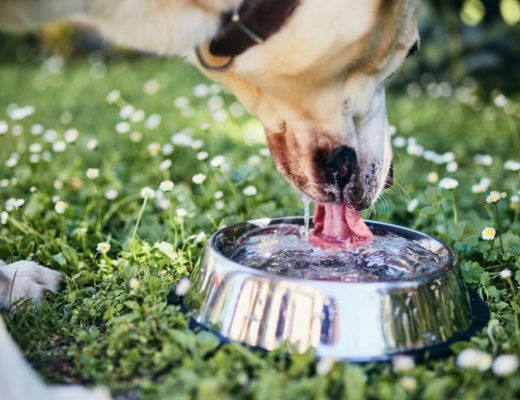As pet owners, we often forget that holidays like Easter can pose serious risks to our furry friends. While we enjoy indulging in festive treats and decorations, we must remember that our pets may not be able to handle these items in the same way we can.

- Contents:
- Toxic chocolate
- Poisonous lilies
- Dangerous plants
- Risky Easter grass
- Hazardous decorations
- Harmful table scraps
- Toxic alcohol
- Deadly xylitol
- Conclusion
Toxic chocolate
Firstly, chocolate is one of the most common Easter toxins that can be dangerous to dogs. Chocolate contains a substance called theobromine that dogs cannot metabolize correctly. Even a small amount of chocolate can cause vomiting, diarrhea, and seizures in dogs. Therefore, it’s crucial to keep all chocolate out of your dog’s reach. Chocolate is not only a risk for dogs but also for cats, so it’s crucial to keep all chocolate away from your pets. Dark chocolate and baked chocolate are especially toxic to pets due to their higher concentration of theobromine. If you suspect that your pet has ingested chocolate, contact your veterinarian immediately.
Poisonous lilies
Easter lilies are another dangerous Easter toxin for dogs. These flowers are highly poisonous and can cause kidney failure in dogs, even in small amounts. If you have Easter lilies in your home, keep them away from your pets. In addition to Easter lilies, other common springtime flowers such as azaleas, rhododendrons, and chrysanthemums can be toxic to pets. These plants contain toxins that can cause vomiting, diarrhea, and even cardiac failure in pets. If you’re unsure if a particular plant is safe for your pet, it’s best to err on the side of caution and avoid it altogether.
Dangerous plants
Besides Easter lilies, there are several other plants that can be dangerous for dogs during the holiday. For example, tulips contain toxins that can cause gastrointestinal problems, depression, and even seizures in dogs if ingested in large quantities. Similarly, daffodils contain lycorine, a toxic substance that can cause vomiting, diarrhea, abdominal pain, and even respiratory distress in dogs.
Hyacinths are another popular Easter plant that can pose a risk to dogs. The bulbs of hyacinths contain a toxin called oxalic acid, which can cause skin irritation, vomiting, and diarrhea in dogs. Ingesting large amounts of hyacinths can lead to more severe symptoms, including difficulty breathing and collapse.
Another plant to avoid during Easter is the azalea. This plant contains grayanotoxins that can cause vomiting, diarrhea, weakness, and even coma or death in dogs. Symptoms usually appear within a few hours of ingestion, and prompt veterinary attention is necessary.
| Plants | Toxicity | Symptoms | ? Safety tip |
| ? Easter Lilies | ? Severe | Kidney failure | ? Keep away from pets |
| ? Azaleas | ? Severe | Vomiting, diarrhea, weakness, coma, death | ? Keep out of reach and seek prompt veterinary attention |
| ? Hyacinths | ? Moderate | Skin irritation, vomiting, diarrhea, difficulty breathing | ? Keep out of reach and avoid ingestion in large amounts |
| ? Daffodils | ? Moderate | Vomiting, diarrhea, abdominal pain, respiratory distress | ? Keep out of reach and avoid ingestion |
| ? Tulips | ? Moderate | Gastrointestinal problems, depression, seizures | ? Keep out of reach and avoid ingestion in large quantities |
| ? Chrysanthemums | ? Mild | Vomiting, diarrhea | ? Keep out of reach |
Risky Easter grass
Easter grass is a common decoration during the holiday, but it can pose a significant risk to pets. The grass is often made of thin plastic or paper material, which can be easily ingested by pets. If ingested, Easter grass can cause intestinal blockages, which can lead to serious health complications in pets.
Symptoms of intestinal blockage in pets include vomiting, diarrhea, constipation, abdominal pain, and lack of appetite. These symptoms can be severe and may require immediate veterinary attention. Therefore, it’s best to keep all Easter grass out of your pet’s reach.
If you must use Easter grass as a decoration, make sure to supervise your pets closely to prevent them from chewing or ingesting it. Additionally, ensure that all Easter grass is disposed of properly, so your pets cannot access it later.
Hazardous decorations
Easter decorations can pose a hazard to dogs, especially if they are not closely supervised. Dogs may be tempted to chew or swallow decorations, such as plastic eggs or small toys, which can cause choking or intestinal blockages. Tinsel and ribbons used for decorating Easter baskets can also be hazardous if ingested, as they can cause intestinal obstructions.
Additionally, lit candles can be a fire hazard if knocked over by a curious pet. It’s important to make sure all decorations are out of your pet’s reach and to supervise them closely when around potentially hazardous items. By taking these precautions, you can help keep your furry friends safe and healthy during the Easter holiday.
Harmful table scraps
Feeding table scraps to pets during Easter can be harmful, especially if the food contains fatty meat and bones. These scraps can cause pancreatitis in dogs, which is a condition that affects the pancreas and causes vomiting, diarrhea, and abdominal pain. Therefore, it’s essential to avoid feeding your pets any table scraps during Easter and opt for dog-friendly treats instead.
Toxic alcohol
Alcohol is a common part of many Easter celebrations, but it’s vital to keep all alcoholic drinks out of your pet’s reach. Even small amounts of alcohol can cause intoxication, coma, and death in dogs. Symptoms of alcohol poisoning in dogs include vomiting, diarrhea, difficulty breathing, and seizures. Therefore, it’s best to keep all alcoholic drinks away from your pets.

Deadly xylitol
Xylitol is a sugar substitute found in many sugar-free gum and candy products. It can be highly toxic to dogs, causing a sudden drop in blood sugar levels, seizures, liver failure, and even death. Therefore, it’s essential to keep all products containing xylitol out of your pet’s reach during Easter. Be sure to read the labels on any candy or gum before bringing them into your home and dispose of any products containing xylitol properly. If you suspect that your pet has ingested xylitol, seek immediate veterinary care.
@8pawsclub ???Dog Behaviorist Advice: Avoid These Easter Pet Toxins Keep your furry friends safe this Easter by avoiding these common pet toxins. Learn from a dog behaviorist on how to keep your pets healthy and happy during the holiday season. #dogbehaviorist #pettoxins #eastersafety #pethealth #safetytips #doglovers #puppylove #petsofinstagram #cutedogs #petadvice #toxicchocolate #poisonouslilies #dangerousplants #riskygrass #hazardousdecorations #tablescrapdangers #toxicfoods #xylitol #alcoholtips #petowners #easterpets #holidaytips #dogcare #petawareness #prevention #peteducation #tiktokpets #tiktokdogs #petcaretips #8pawsclub
♬ original sound – Dog Behavior & Welfare Trainer
Conclusion
In conclusion, Easter can be a fun time for pet owners and their furry friends, but it’s important to take precautions to keep them safe. As a dog behaviorist, I recommend keeping all toxic items out of your pet’s reach and supervising your pets closely during the holiday. By taking the necessary precautions, you can ensure that your pets stay healthy and happy during this festive season.
FAQ
Why is chocolate toxic to dogs?
Chocolate contains a compound called theobromine, which dogs metabolize much more slowly than humans. This leads to a buildup of theobromine in their system, which can cause vomiting, diarrhea, seizures, and even death.
What are some signs that my dog has ingested toxic substances?
Symptoms can vary depending on the type of toxin and the amount ingested, but common signs include vomiting, diarrhea, lethargy, loss of appetite, tremors, seizures, and difficulty breathing.
Can Easter lilies really be deadly to cats?
Yes, Easter lilies are highly toxic to cats and can cause kidney failure if ingested. Other lilies, including Asiatic, Day, and Tiger lilies, are also toxic to cats and should be kept out of their reach.
What are some pet-friendly alternatives to Easter grass?
Paper or cloth grass, shredded paper, or even dried moss can be used as a safe alternative to traditional Easter grass.
Are there any safe table scraps that dogs can eat?
While it’s generally best to avoid feeding your dog table scraps, some safe options include plain cooked meats (without seasoning), cooked vegetables, and plain rice or pasta.
Can dogs get alcohol poisoning?
Yes, dogs can get alcohol poisoning from consuming alcoholic beverages, which can cause vomiting, diarrhea, difficulty breathing, tremors, and in severe cases, coma or death.
What is xylitol, and why is it dangerous for dogs?
Xylitol is a sugar substitute commonly found in sugar-free gum, candies, and baked goods. It can cause a rapid insulin release in dogs, leading to hypoglycemia (low blood sugar), seizures, and liver failure.




